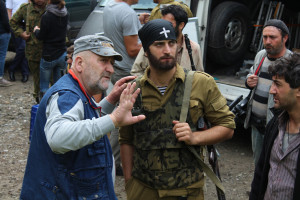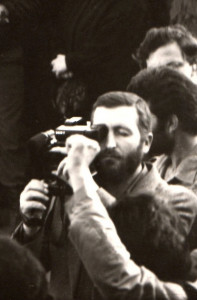WEAPON CAMERA ON THE SHOULDER…
 ‘When the Artsakh war broke out, I faced a dilemma: to choose a weapon or a camera. I made sure that there were a lot of people taking up arms and decided that my weapon would be the camera. I accepted the strictest principle for myself: I am only a documentarian. I’m just going to film, no other participation. The pain of human loss, the tremors of war, everything would be material for me. Otherwise, it would not be possible to show the reality, to convey the real spirit of the war.” About 1,200 hours of video from various combat hotspots, documented 18 videos of the liberation of Shushi, which unfortunately were burnt in the plane hit by Azeris. Two serious wounds and a very interesting life with the memories of Shavarsh Vardanyan, one of the founders of the newly formed news service, cameraman of the Hayfilm studio and the director of the “My Cross” film.
‘When the Artsakh war broke out, I faced a dilemma: to choose a weapon or a camera. I made sure that there were a lot of people taking up arms and decided that my weapon would be the camera. I accepted the strictest principle for myself: I am only a documentarian. I’m just going to film, no other participation. The pain of human loss, the tremors of war, everything would be material for me. Otherwise, it would not be possible to show the reality, to convey the real spirit of the war.” About 1,200 hours of video from various combat hotspots, documented 18 videos of the liberation of Shushi, which unfortunately were burnt in the plane hit by Azeris. Two serious wounds and a very interesting life with the memories of Shavarsh Vardanyan, one of the founders of the newly formed news service, cameraman of the Hayfilm studio and the director of the “My Cross” film.
“I took the camera in my hand for the first time when I was still a conscript. This is an unusual case when you have to choose your profession by lying,” says Shavarsh. “I served in the Soviet army. Initially, in a military unit located in Georgia. I was a very indisciplined soldier. When I was to be transferred to another military unit as a sergeant six months later, I was in an army prison. I arrived in Yerevan late. I remember reporting to General Kazarlovsky: “I have arrived from Georgia.” “Why are you late?” At that moment, I don’t know how it occurred to me to cheat. I said, “I was making a film about a training military unit. I finished, they just let me go, General.” The look softened, the officers were happy. “Oh, that’s great. You will keep this soldier as a photographer.” My whole body trembled at that moment, what was I going to do? I didn’t even know how to hold the camera properly. I asked one of my friends to teach me how to take pictures. Within a week, I learned to take photos and print photos. It was already a matter of honor, I said I had to do my job well. I was taking photos for the Zvezda newspaper. But it was also possible to show the movement, wasn’t it? I found a video camera and started recording the training. Then I equipped the installation equipment with a thousand and one tricks to install my materials. And I didn’t understand how became obsessed. My choice was to become a cinematographer. I was admitted to the All-Union Film Institute in Moscow. I worked at a Russian studio first as an illuminator, then as an assistant cameraman. Then I started working at Hayfilm.
Before the war, Shavarsh Vardanyan had done some interesting cinematography in the Hayfilm” one of which was “A Piece of Heaven” (in 1982 as the second cameraman). He remembered a funny incident from the shooting. “We needed an old, wooden gate for the episode where Torik followed the chickens. We searched and found a house with a wonderful wooden gate, and filmed the scene. The next day, when we had to continue filming, we saw with horror that the gate was painted black. Before our arrival, the landlord “made sure” that his gate looked beautiful in the movie.
 The country was in turmoil. The Artsakh movement was gaining momentum. He started filming important episodes of the rallies. He was already in Artsakh in February, filming the developments. “I realized that it is crucial to participate in military operations. I understood footage of the Genocide was so little, and almost all of it was filmed by foreigners, so this time we had no right to record it while we are cameramen. The first camera I took with me to the battlefield was that of Gvorg Emin’s. “You are going to battlefields,” he said excitedly. “You’re going to record the battles. What more can I use this camera for? Take it.” A story was being unfoled that had to be passed down through the generations. Since 1988, Shavarsh Vardanyan has been in Artsakh more than at home.
The country was in turmoil. The Artsakh movement was gaining momentum. He started filming important episodes of the rallies. He was already in Artsakh in February, filming the developments. “I realized that it is crucial to participate in military operations. I understood footage of the Genocide was so little, and almost all of it was filmed by foreigners, so this time we had no right to record it while we are cameramen. The first camera I took with me to the battlefield was that of Gvorg Emin’s. “You are going to battlefields,” he said excitedly. “You’re going to record the battles. What more can I use this camera for? Take it.” A story was being unfoled that had to be passed down through the generations. Since 1988, Shavarsh Vardanyan has been in Artsakh more than at home.
 The memories are plenty. Where it was hot or interesting, he was there. In Shahumyan, he even managed to shoot the beginning of the “Koltso” operation. “A high-ranking Russian officer, Gen Malishkin, persuaded me, ‘Let me take you, let’s go.’ Why did he want me to go? He escorted me to the helicopter, confident that I would leave. I managed to escape. I wondered what would happen. And I saw Russian tanks coming. Shortly afterwards, USSR Defense Minister Gen Yazov, accompanied by the Minister of Internal Affairs, landed on Mi-24. Seeing me and the camera, he was surprised. “Who are you…” After Yazov left, the “Koltso” operation began …
The memories are plenty. Where it was hot or interesting, he was there. In Shahumyan, he even managed to shoot the beginning of the “Koltso” operation. “A high-ranking Russian officer, Gen Malishkin, persuaded me, ‘Let me take you, let’s go.’ Why did he want me to go? He escorted me to the helicopter, confident that I would leave. I managed to escape. I wondered what would happen. And I saw Russian tanks coming. Shortly afterwards, USSR Defense Minister Gen Yazov, accompanied by the Minister of Internal Affairs, landed on Mi-24. Seeing me and the camera, he was surprised. “Who are you…” After Yazov left, the “Koltso” operation began …
By KNAR TADEVOSYAN
Photos from Shavarsh Vardanyan’s personal archive
Category: #20 (1340) 20.05.2020 - 26.05.2020, Army and Society, Spotlight










